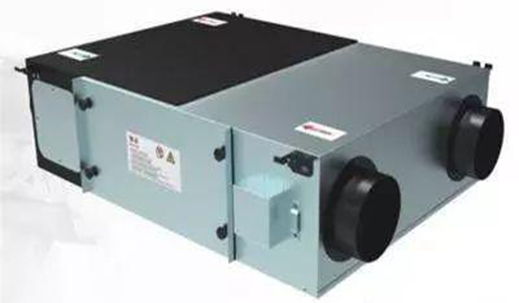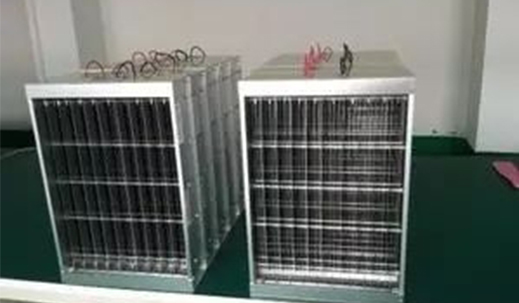In recent years, everyone has a deep understanding of smog, and various businesses have also made great efforts to improve livability. Many markets have introduced fresh air systems for this purpose. “What is the fresh air system? Can the fresh air system really keep PM2.5 out of the door?” Faced with questions from all sides, today we will explain the downwind system, trying to restore the “true face” of the fresh air system for everyone.
What is a fresh air system?
The fresh air system is an independent air treatment system composed of a fresh air ventilator and pipeline accessories. The fresh air ventilator filters, purifies, and preheats the outdoor fresh air, transport it to the room through the pipeline, and at the same time discharges the indoor dirty air to the outside. It is a replacement air system. Its core is the fresh air ventilator!
 Classification of fresh air systems
Classification of fresh air systems
One-way flow fresh air system
It consists of fans, air inlets, air outlets, and various pipes and joints. The fan installed in the ceiling is connected to a series of exhaust ports through pipes, the fan starts, and the indoor turbid air is discharged to the outside through the fan installed in the indoor suction port, forming several effective negative pressure areas in the room. The indoor air continuously flows to the negative pressure area and is discharged to the outside, and the outdoor fresh air is continuously replenished to the interior by the air inlet installed above the window frame (between the window frame and the wall) so that you can always breathe high-quality fresh air.
There is no need to connect the air supply duct, and the exhaust duct is generally installed in aisles, toilets, and other places where there are usually suspended ceilings, and basically does not take up additional space.
Different from the one-way flow, the fresh air of the two-way flow is fed into the room by the new air host through the air supply duct. There are power and pipes at the air inlet and exhaust port, and the air is supplied and exhausted to the room through machinery and pipes. . There are also many types of two-way flow fresh air systems, the common ones are:
1. Corresponding type of sending and discharging:
That is, a new air outlet corresponds to an exhaust outlet, which can keep the air volume of each room balanced.
Advantages: each room can form an independent space, the effect is the best;
Disadvantages: The pipeline is complicated, each room needs an additional exhaust duct, and holes may be drilled in the beam, which is costly.
2. Multi-send single row type:
That is, multiple new air outlets, corresponding to 1-2 air outlets, and the air outlets can be located in the hallway, bathroom, balcony, and other ground rooms.
Advantages: The pipeline is relatively simple. If the air is supplied together, there is almost no need to drill holes in the beam (the new air outlet is on the ground, and the air outlet is near the host), and the cost is low;
Disadvantages: The door of each room needs to leave a little gap, otherwise it is difficult to achieve ventilation).
The purpose of the fresh air system
- With purification
The fresh air system with purification can be used in a variety of environments, whether you are in a smog-closed area or an area with good air, It can ensure indoor ventilation and exhaust the dirty air outside, and efficiently provide oxygen-rich air for indoor people to breathe.
- Without purification
The basic function of fresh air without purification is heat exchange. Manufacturers and merchants also collectively call it a “fresh air system”, which will bring people the illusion of purchasing. After you buy it, you will find that this type of fresh air has no systematic filtering device at all, and this kind of equipment is only suitable for use in places where the air is very good. For example, the average air quality is within 30, and the filter device can only filter larger particulate matter such as mosquitoes and flies, fluff, etc., and cannot filter PM2.5.
What is a total heat exchanger fresh air system, in simple terms, it is a fresh air system with a total heat exchanger, which can ensure that the air inlet and outlet air are at the same temperature, and truly achieve indoor constant temperature and oxygen. The fresh air system with full heat exchanger can let you enjoy life more comfortably and let you no longer worry about indoor air quality.
This is a technological dream. Since the birth of the HEPA filter, Europeans have always hoped to achieve full purification of air pollution. However, so far, the top-level HEPA filter cannot filter pollutants with a diameter of fewer than 0.3 microns (ie PM0.3), because the HEPA filter is, after all, the purification technology mainly aimed at coal dust in the past. It is the filtration of physical pores method unless your net is complete “tight airtight”, otherwise PM0.3 will pass through the mesh with ease.
It is precisely PM0.3, which can be suspended in the air for 1000 kilometers without settling. It is nothing to directly enter the blood and enter the lungs. They can directly penetrate the cell wall of the human body, block the blood vessels, make the blood dirty, and cause cell necrosis. They are the most ferocious in the dirty air killer.
The electrostatic dust box captures small particles through ion clusters released by electrostatic high voltage, not to mention PM0.3, pollen, bacteria, viruses, soot, and even gas molecules, car exhaust, etc.
More than 2,000 kinds of fine suspended solids in the air are all within the capture range of the dust box.

 Español
Español Русский
Русский Tiếng Việt
Tiếng Việt 中文
中文 suomi
suomi Français
Français Português
Português English
English Deutsch
Deutsch Français
Français Español
Español Italiano
Italiano Português
Português Pусский
Pусский





